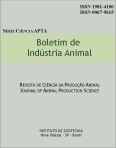Chlorophyll evaluation methods in Brachiaria brizantha brs Piatàadded with poultry litter compost
Keywords:
B. brizantha BRS Piata, chlorophyll, DualexAbstract
One of the major limitations for pastures high production is the low fertility of tropical soils. In general, the nutrient reposition through chemical fertilizers increases the cost of production and can unbalance the plant besides the environment pollution. Recycling solid residues from agribusiness is a sustainable alternative for farmers. Among the residues, the poultry litter (PL) aerobically fermented is a very good bio fertilizer for pastures. The PiatàGrass (Brachiaria brizantha) is a new option for the pasture market and can be used for bovine, equine or ovine. The fast diagnosis of the nutritional stage of this plant, based upon portable methods as the Dualex, measuring leaf light reflectance is a practical alternative. By this way, it is possible to offer to the herd high nutritional food, correcting eventual shortage, mainly nitrogen. Nitrogen nutrition is directely related to chlorophyll content in the leaf blade. This study aimed to verify the effects of doses of PL over total chlorophyll, in comparison to two methods of evaluation: Dualex Scientific 4.0 and Spectrophotometer Analysis according to Lichtenthaler & Wellburn (1983). The experiment was conducted in greenhouse conditions, at IZ, Nova Odessa, with a Haplortox soil, between May and July, 2013. Treatments consisted of five compost doses (PL): 0, 20, 40, 60 and 120 Mg ha-1, with the following chemical composition (%): 2.88 of N, 3.85 of P2O5, 2.50 of K2O, 9.06 of Ca and 1.16 of Mg. The experimental design was on randomized blocks with five replications. Data were analyzed using the GLM procedure of the SAS program. Chlorophyll data were taken from the third medium of the leaf blade from a third of the expanded leaf from the apical using the Dualex. At the same time, samples were harvested for the Spectrophotometer analyses according to methodology described by Lichtenthaler & Wellburn (1983). Total Chlorophyll amounts were increased with the higher doses of PL, adjusting quadratic to the equations: Chlorophyll-Dualex= -0.003PL2 + 056PL + 28.9 (R2= 0.84), and for Lichtenthaler & Wellburn methods Chlorophyll = -0.003PL2 + 0.052 PL + 24.8 (R2=0.76). Chlorophyll values were similar with both methods used. The Dualex method is faster and easier than the spectrometric method. The use of PL disables the improvement of photosynthetic potential and forage yield. Further studies are necessary to determine the correct use of those organic residues in degraded areas as well as in small production areas.Downloads
Downloads
Published
Issue
Section
License
Os autores não serão remunerados pela publicação de trabalhos, pois devem abrir mão de seus direitos autorais em favor deste periódico. Por outro lado, os autores ficam autorizados a publicar seus artigos, simultaneamente, em repositórios da instituição de sua origem, desde que citada a fonte da publicação original seja Boletim de Indústria Animal. A revista se reserva o direito de efetuar, nos originais, alterações de ordem normativa, ortográfica e gramatical, com vistas a manter o padrão culto da língua e a credibilidade do veículo. Respeitará, no entanto, o estilo de escrever dos autores. Alterações, correções ou sugestões de ordem conceitual serão encaminhadas aos autores, quando necessário. Nesses casos, os artigos, depois de adequados, deverão ser submetidos a nova apreciação. As opiniões emitidas pelos autores dos artigos são de sua exclusiva responsabilidade. Todo o conteúdo deste periódico, exceto onde está identificado, está licenciado sob a Licença Creative Commons Attribution (CC-BY-NC). A condição BY implica que os licenciados podem copiar, distribuir, exibir e executar a obra e fazer trabalhos derivados com base em que só se dão o autor ou licenciante os créditos na forma especificada por estes. A cláusula NC significa que os licenciados podem copiar, distribuir, exibir e executar a obra e fazer trabalhos derivados com base apenas para fins não comerciais.













